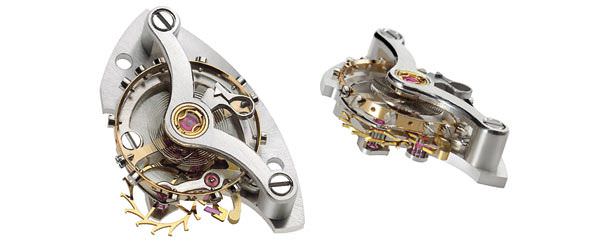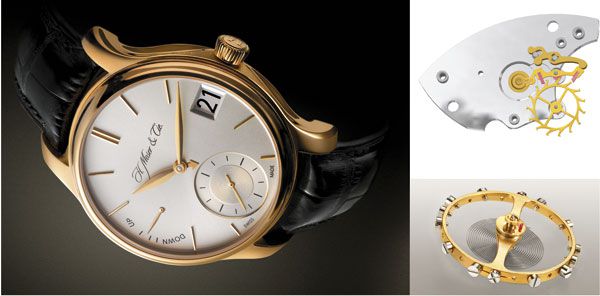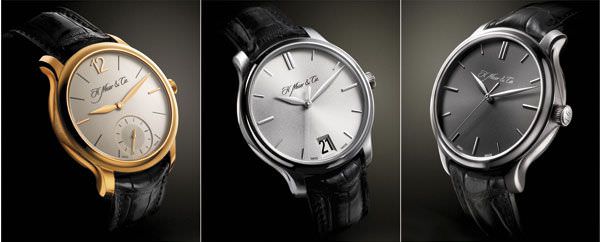The mechanical watches presented by this Schaffhausen-based brand are not only remarkable from a strictly timekeeping point of view (we will come back to that in great detail below), but they are also surprising because of their splendid understatement.
Against a backdrop of over-the-top designs where many brands are using the most showy forms and materials possible, seeking to show off their ‘muscles’ by creating multiple windows to the guts and gears of its pieces, H. Moser & Cie stands apart. It offers watches that are round, perfectly proportioned, not too small, not too big, devoid of superfluous ornamentation, with lines that take the notion of purity to the extreme. These timepieces go straight to the essential, displaying hours, minutes, and seconds.

Escapment module
A particular magic
So, where, then, does the special ‘magic’ that emanates from these watches come from? Why does one have the feeling that they are timeless, that they will not fall out of fashion, that they will most probably ‘bury’ many of their more flamboyant competitors? What creates this superb natural elegance, this subtle distinctiveness, which immediately attracts attention?
The answers to these questions can be found in the great many details that result from an approach based on the grand traditions of timekeeping. Let’s look at the case, for example. It is round, nothing new there, but its sides are delicately carved into arches on each side of the crown, which gives it a special lightness and sensuality, while allowing a very fine play of light on the alternate polished surfaces. But, while the case may seem rather classic, it is nonetheless technically quite complex. Made up of not less than 27 elements, it is equipped with seven seals that enclose and protect the movement. A subtly rounded, and anti-reflective, sapphire crystal offers an in-depth view of the delicately worked dial, offering greater readability with its long tri-dimensional hands and facetted indices. The lightly enhanced horns hold a leather strap that is perfectly adapted to the shape of the case. Another important detail is the rather large, but very elegant, and easy-to-use crown. For models with a date indicator, the crown is also equipped with a mechanism unique to Moser called the ‘Double Pull Crown (DPC)’. Although this is only a detail, it says a lot about the attention that H. Moser & Cie pays to the comfort of the user. Owners of mechanical watches with a date indicator know that it is sometimes difficult to find the exact position for adjusting the date, and that often the time is inadvertently changed instead. With the DPC, this cannot happen since it is necessary to pull the crown to the first stop, and then release it before being able to pull it out to the second position, which permits the hands to be adjusted.

MOSER PERPETUAL 1, the ‘Dragon lever’ and the balance
A major innovation
Under the radical but sensual purity of their appearance, H. Moser & Cie watches contain original movements (four in-house, manual-winding mechanical calibres) which provide a good demonstration of the timekeeping rigour of the brand.
This is not rigour for rigour’s sake or simply ‘art for art’s sake’, but is entirely conceived in view of increasing the simplicity, utilization, comfort, ergonomics, readability, and durability of a perfectly functioning mechanical timepiece. It also addresses the strategic necessity, and even imperativeness, of being able to offer irreproachable service.
At the core of the notion of service can be found a major innovation that H. Moser & Cie is alone to offer: an interchangeable escapement module that is common to all its movements. All the regulating organs of the watch are thus united in a module that only needs to be unscrewed at two points in order to detach and interchange it.
“The main idea behind this innovation,” explains Daniel W. Zimmermann, Director Sales & Marketing, “is to efficiently respond to the great challenge today that concerns all the brands working in high level mechanical timekeeping: service. Throughout the world, there are simply not enough trained watchmakers capable of repairing complex movements. And, after five or six years of operation, a watch needs to be adjusted, and lubricated. Basically, it needs a complete servicing, which can take weeks, or even months, during which the clients are deprived of their watches, and does not even count the prices that are being charged. With our system, the client goes to the watchmaker, who then removes the escapement module, easily cleans and oils the rest of the movement, then replaces the escapement module with another, pre-regulated module that we have provided. The client thus only has a short wait, and can usually leave with his watch. This gives the watchmaker time to then take care of the original module, and to then put it back in place once it is adjusted.” This ingenious and duly patented idea will undoubtedly make many other prestigious brands green with envy.

MAYU, MONARD DATE and MONARD
A few key details
But the ingenious creativity of the watchmakers at H. Moser & Cie doesn’t stop there. It is also seen in the way that the escapement itself has been designed and in the intrinsic quality demonstrated by several details. For example, the regulating screws (0.35 mm in diameter) of the large balance are slotted, thus preventing them from losing adjustment due to vibrations. Another ‘detail’ is seen in the very delicate palette and the palette wheel, which are made in gold, which has been hardened, not by hammering, but by a hardening process known as Röutgenstrahltiefeulitographie or LIGA, that takes the metal to 600 vickers and allows it to obtain particularly smooth vertical surfaces, thus reducing the friction between the jewel of the palette fork and the teeth of the escape wheel. The timekeeping precision is also facilitated by another device called the ‘dragon lever’ that lets the distance between the palette and the escape wheel be adjusted with great accuracy.
The movements of H. Moser & Cie are currently equipped with a Breguet Nivarox balance. In the near future, however, the brand will make its own balance springs, realized in collaboration with the firm, Precision Engineering, which was able to purchase the ‘original recipe’ of the Nivarox alloy, whose inventor was none other than the grandfather of one of the principal shareholders of H. Moser & Cie, the industrialist Thomas Straumann. H. Moser & Cie has no intention of verticalizing its entire production process and becoming a ‘manufacture’ though. While the overall ensemble of its devices, calibres, movements and cases are designed and developed in-house, the Schaf-fhausen brand has them manufactured by a series of sub-contractors, mainly located in the Jurassian Arc region.
The most beautiful perpetual calendar
The many features of the H. Moser & Cie movements are expressed particularly well in the emblematic model called the Moser Perpetual 1. This is quite simply the most classic, the most evident, the simplest, and the most readable perpetual calendar ever created. Two of its characteristics are just amazing: first of all is the very short and large arrow-shaped central hand that indicates the month of the year, simply by pointing at one of the twelve indices, with each index corresponding to a different month; and secondly, the very large, instantaneously jumping date.
For a start, this very large date does not appear in two parallel windows, but in only one. Thus the date, whether one number or two, is always perfectly centred, for example, as a real ‘1’ and not ‘01’.
Also, quite interestingly, the ‘Flash Calendar’ of the Moser Perpetual 1 offers not only an instantaneously jumping date, but it is adjustable backwards or forwards at any given moment by simply activating the winding crown placed in the intermediate position. It also offers the particularity of jumping directly from the last day of the month to the first day of the next month without ever having to pass by the days in between. For example, this patented system instantaneously passes from 30 to 1, from 31 to 1, and from 28 to 1, or in the case of leap years, from 29 to 1.
The star indicating leap years is visible on the back of the watch, which can easily be adjusted, if necessary, using an inconspicuous corrector on the side of the case.
Essential, pure, ultra-readable, devoid of any superfluous indication (thus there is no year indication, but who needs it, anyway?), the Moser Perpetual 1, in its delicately curved case, is without contest the watch of the year.
Mayu and Monard
Mayu and Monard are the two collections at the summit of the brand’s family of watches. With its 38.8 mm diameter and 9.3 mm thickness, the Mayu line has a small seconds hand at 6 o’clock with a large diameter, inspired by pocket watches, and located against the edge of the piece. Only a very large calibre – 32 mm or 14 lines – permits this rather rare positioning and immediately differentiates this watch from the Valjoux or other ETA calibres. It has only one large barrel, which offers 80 hours of power reserve, whose indicator is visible on the back.
The Monard line, with a diameter of 40.8 mm, is equipped with two barrels giving a power reserve of seven days. It displays the hours, minutes, small central seconds hand, and a large date at 6 o’clock. With a production of 500 pieces in 2006, 750 pieces for 2007, the long-term objective is 5000 watches per year. It is currently in 25 sales points in twelve countries.
With its quite reasonable price/quality ratio, the pieces are available only in white or rose gold and platinum (starting at 12,500 CHF for the basic Mayu up to 36,000 CHF for a gold Moser Perpetual 1). This is clearly a brand to watch.
Where does the name H. Moser & Cie come from?
Many have forgotten, but Heinrich Moser, born in 1805 in Schaffhausen, a descendant of a watch dynasty and himself a watchmaker, emigrated to Russia at the age of 22, where he rapidly established a veritable timekeeping empire under the name of H. Moser & Cie. For his supplies, he founded a factory in Le Locle and also purchased parts from Urban Jürgensen and Jaeger-LeCoultre.
At its height, H. Moser & Cie had 70 different calibres, sold watches to the Imperial Court of Russia, as well as delivered large quantities of timekeepers to Japan, China, Persia, Paris, and New York. Upon his return to his native Schaffhausen, Heinrich Moser contributed greatly to the industrial boom of his city, notably with the construction of a hydroelectric dam on the Rhine, as well as attracting F. A. Jones, the founder of IWC. At his death in 1874, his heirs sold his Russian possessions. The factory in Le Locle continued to produce mechanical movements until 1980, when it closed its doors for good.
The renaissance of H. Moser & Cie is due to the initiative of one man, Dr. Jürgen Lange. Originally from East Germany, he worked for a long time at IWC before deciding to branch out on his own. Gathering together a small group of investors, he re-launched H. Moser & Cie, with Roger Balsiger, a direct descendant of Heinrich Moser, becoming the Honorary President of the Board of Directors and Ambassador for the brand.
Source: Europa Star February-March 2007 Magazine Issue





